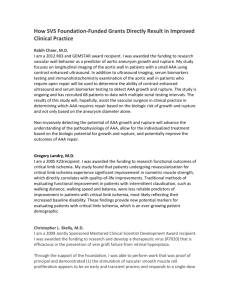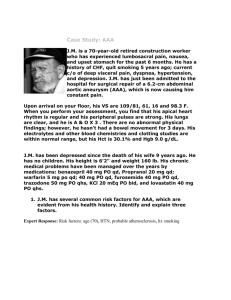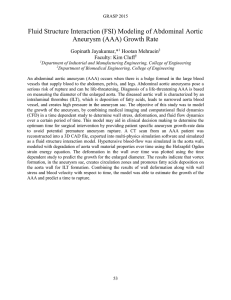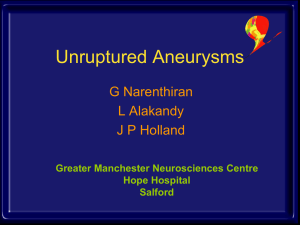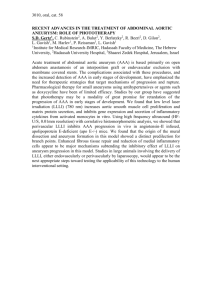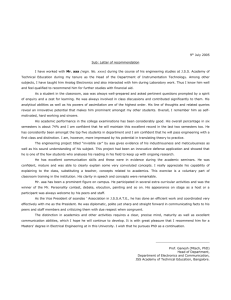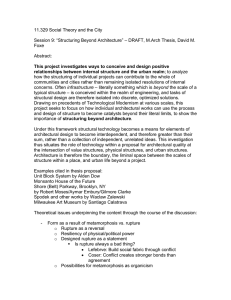Osler Journal Club Dan Munoz and Adnan Malik September 13, 2006
advertisement
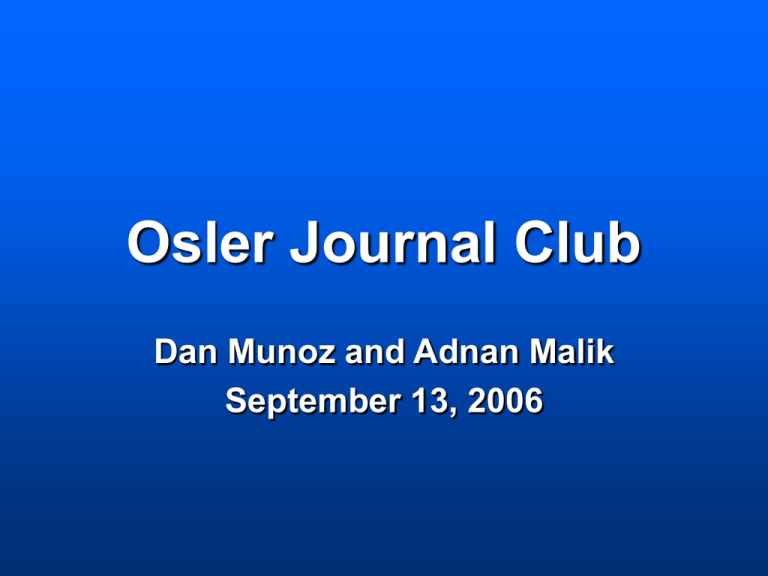
Osler Journal Club Dan Munoz and Adnan Malik September 13, 2006 Background • Population-based case-control study • Investigating association between ACE inhibitors and abdominal aortic aneurysm (AAA) rupture • Based on animal data suggesting that ACE inhibition may prevent expansion and rupture of AAA’s • AAA’s are common (4-8% of men > 50 yrs) • Mortality of AAA rupture is 80-90% Study Outline • 15,326 consecutive patients, greater than 65 in age, admitted with primary diagnosis of ruptured or intact AAA over a 10 year period (1992-2002) • Data derived from four linked administrative databases in Ontario, Canada: 1. Ontario Drug Benefit database 2. Canadian Institute for Health Information Discharge Abstract database 3. Ontario Health Insurance Plan database 4. Ontario Registered Persons database Study Outline • Analysis looks at association between ACE inhibitor use prior to admission and odds of admission for unruptured vs. ruptured aneurysm (primary diagnosis responsible for admission) • Primary outcome = AAA rupture • Multivariable analysis performed to adjust for demographics, risk factors for aneurysm rupture, comorbidities, health care access and screening Results • Table 1. Baseline characteristics of patients. • Cases=patients with AAA rupture • Controls=patients with unruptured AAA • Notable for higher rate of imaging, electrocardiography, and cholesterol testing in control group • Other health measures, comorbidities were similar Results • Patients receiving ACE-I before admission significantly less likely to present with ruptured aneurysm, OR 0.82 (CI 0.740.90) • Dosing and specific type of ACE inhibitor did not affect association • Table 2. Other antihypertensives were not associated with lower incidence of AAA rupture Implications • Association between ACE-I use and reduced risk of aortic rupture in elderly population with underlying AA Dx • Potentially unique effect of ACE-I among anti-hypertensives in imparting protection against rupture • Animal models and this study suggest current role for ACE-I Rx in selected subpopulations, while we await more definitive clinical investigation Strengths of Approach • • • • Rarity of condition (M 4-8%, F 0.5-1%, age >50) makes case-control design useful/practical Canadian HC system imparting uniformity of access to hospital care, physician services Rx drug coverage – Use of national utilization databases – Further attempts to control for case-mix: no obvious inherent health status differences between groups Selection of controls – (+) Demonstrated unruptured aneurysms – (-) Question of how coming to attention Findings not overstated – Authors caution: association vs. causation – Direction: non-surgical candidates, trials Weaknesses of Approach • Inherent to case-control design – Missed populations • Ruptures not making it to medical attention • Silent, undiagnosed aortic aneurysms • Absence of detailed info on smoking status – Major risk factor for AA enlargement • 10 year experience – Uniformity of intervention/technique quality? • Definition of ACE-I therapy (Rx record) – Adherence/administration difficult to verify Discussion Points • How might this study have been better designed? Do you agree with the case-control model here? • What other primary endpoints would be clinically relevant in examining ACE-I benefits/effects? – Rate of enlargement, threshold size, etc. • What would be next investigational step? – How might a RCT be feasibly designed? References • Hackam D, et al., “Angiotensin-converting enzyme inhibitors and aortic rupture: a population-based case-control study,” Lancet 2006, 368: 659-665 • Dr. Jeanne Clark, Division of GIM Taxonomy of Clinical Research Designs Experimental • Controlled Trials – Non-Randomized – Randomized • Other Intervention Studies – Before vs After – External Controls – Historical Controls Observational • Prospective Cohort Study – Concurrent – Non-Concurrent • Case-Control Study • Cross-Sectional Study • Other / Mixed / ? Comparison of 4 Major Study Designs Goal or Feature RCT PCS CC X-S • Estimate Prevalence • Estimate Incidence • Prove Causality F BA+ F A+ B+ F F B- A+ F D • Generalizability • Feasibility BC AB AA A A RCT=Randomized, controlled trial; CC=Case-control study; PCS=Prospective cohort study; X-S=Cross-sectional study Case Control Studies • Ppts selected on disease – Present = cases; Absent = controls – Look back at exposures • Etiology – Is head injury more common in pts with Alzheimers? – Is MI more common in women on HRT? • Outcomes – Is history of FOB testing less common in people with colon CA? Examples of Exposures & Outcomes in Clinical Research Exposures • • • • • • • • Traits & Behaviors Genetic Variants Infectious Agents Environmental Toxins Medications Surgical Procedures Behavior Modification Screening Programs Outcomes • Death • Disease • Sub-clinical Indicators of Disease • Health-Related Traits • Quality of Life • Physical Function • Costs
